
Dr. Strangelove or: How I Learned to Stop Worrying and Love the Bomb is a 1964 political satire black comedy film cowritten, produced, and directed by Stanley Kubrick and starring Peter Sellers in three roles, including the title character. The film, financed and released by Columbia Pictures, was a co-production between the United States and the United Kingdom.

K-219 was a Project 667A Navaga-class ballistic missile submarine of the Soviet Navy. It carried 16 R-27U liquid-fuel missiles powered by UDMH with nitrogen tetroxide (NTO). K-219 was involved in what has become one of the most controversial submarine incidents during the Cold War on Friday 3 October 1986. The 15-year-old vessel, which was on an otherwise routine Cold War nuclear deterrence patrol in the North Atlantic 1,090 kilometres (680 mi) northeast of Bermuda, suffered an explosion and fire in a missile tube. While underway a submerged seal in a missile hatch cover failed, allowing high-pressure seawater to enter the missile tube and owing to the pressure differential ruptured the missile fuel tanks, allowing the missile's liquid fuel to mix and ultimately combust. Though there was no official announcement, the Soviet Union claimed the leak was caused by a collision with the submarine USS Augusta. Although Augusta was operating within the area, both the United States Navy and the commander of K-219, Captain Second Rank Igor Britanov, deny that a collision took place.
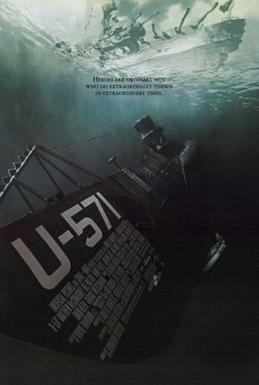
U-571 is a 2000 submarine film directed by Jonathan Mostow from a screenplay he co-wrote with Sam Montgomery and David Ayer. The film stars Matthew McConaughey, Bill Paxton, Harvey Keitel, Jon Bon Jovi, Jake Weber and Matthew Settle. The film follows a World War II German submarine boarded by American submariners to capture her Enigma cipher machine.

K-19: The Widowmaker is a 2002 American historical submarine film directed and produced by Kathryn Bigelow, and produced by Edward S. Feldman, Sigurjon Sighvatsson, Christine Whitaker and Matthias Deyle with screenplay by Christopher Kyle. An international production of the United States, United Kingdom, Germany and Canada, the film takes place in 1961 and focuses its story on the Soviet Hotel-class submarine K-19.

Fail Safe is a 1964 Cold War thriller film directed by Sidney Lumet, based on the 1962 novel of the same name by Eugene Burdick and Harvey Wheeler. The film follows a crisis caused by a critical error that sends a group of U.S. bombers to destroy Moscow, and the ensuing attempts to stop the bomber group before it can deploy a nuclear first strike. The film features performances by actors Henry Fonda, Dan O'Herlihy, Walter Matthau, Frank Overton, Fritz Weaver, Edward Binns, Larry Hagman, Sorrell Booke, Dana Elcar, and Dom DeLuise.
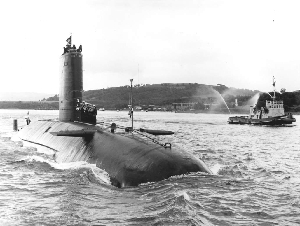
HMS Conqueror was a British Churchill-class nuclear-powered fleet submarine which served in the Royal Navy from 1971 to 1990. She was the third submarine of her class, following the earlier Churchill and Courageous, all designed to face the Soviet threat at sea. She was built by Cammell Laird at Birkenhead.
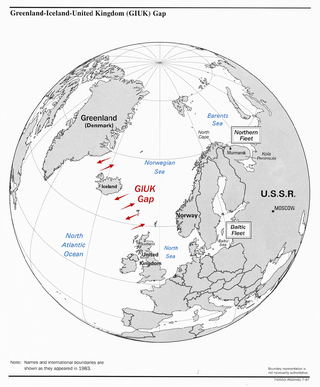
The GIUK gap is an area in the northern Atlantic Ocean that forms a naval choke point. Its name is an acronym for Greenland, Iceland, and the United Kingdom, the gap being the two stretches of open ocean among these three landmasses. It separates the Norwegian Sea and the North Sea from the open Atlantic Ocean. The term is typically used in relation to military topics. The area has for some nations been considered strategically important since the beginning of the 20th century.

USS Scorpion (SSN-589) was a Skipjack-class nuclear-powered submarine that served in the United States Navy, and the sixth vessel, and second submarine, of the U.S. Navy to carry that name.

Down Periscope is a 1996 American military comedy submarine film directed by David S. Ward, produced by Robert Lawrence, and starring Kelsey Grammer, Lauren Holly, and Rob Schneider along with Bruce Dern, Harry Dean Stanton, William H. Macy, and Rip Torn in supporting roles. Released by 20th Century Fox on March 1, 1996, the film focuses on Lieutenant Commander Thomas Dodge, a capable U.S. Navy officer who fights to save his career after being saddled with a group of misfit seamen who have been brought together as the crew of his first command, USS Stingray, a rusty, obsolete World War II-era diesel submarine that is the focus of a special naval war game, supervised by a bitter rival who is fighting to bury Dodge's career by any means necessary.

Operation Petticoat is a 1959 American World War II submarine comedy film in Eastmancolor from Universal-International, produced by Robert Arthur, directed by Blake Edwards, and starring Cary Grant and Tony Curtis.
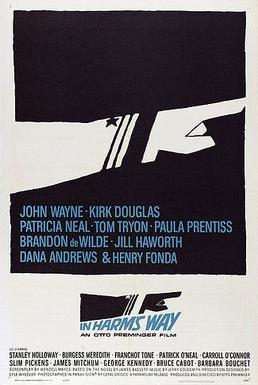
In Harm's Way is a 1965 American epic historical romantic war film produced and directed by Otto Preminger and starring John Wayne, Kirk Douglas, and Patricia Neal, with a supporting cast featuring Henry Fonda in a lengthy cameo, Tom Tryon, Paula Prentiss, Stanley Holloway, Burgess Meredith, Brandon deWilde, Jill Haworth, Dana Andrews, and Franchot Tone. Produced with Panavision motion picture equipment, it was one of the last black-and-white World War II epics, and Wayne's last black-and-white film. The screenplay was written by Wendell Mayes, based on the 1962 novel Harm's Way, by James Bassett.

Corvette K-225 is a 1943 American war film starring Randolph Scott and James Brown, with Ella Raines making her feature film debut. Directed by Richard Rosson, the film was released in the UK as The Nelson Touch. Robert Mitchum, credited as Bob Mitchum, had a minor supporting role, one of 20 Hollywood films he made in 1943. Tony Gaudio was nominated for the 1943 Academy Award for Best Cinematography (B&W) for his work on Corvette K -225.

The Type 15 frigate was a class of British anti-submarine frigates of the Royal Navy. They were conversions based on the hulls of World War II-era destroyers built to the standard War Emergency Programme "utility" design.
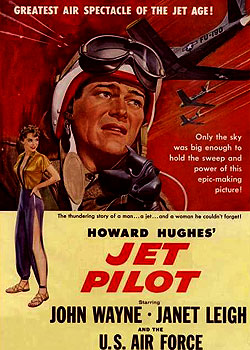
Jet Pilot is a 1957 American Cold War romance film directed by Josef von Sternberg and starring John Wayne and Janet Leigh. It was written and produced by Jules Furthman, and presented by Howard Hughes. Filming lasted more than eighteen months, beginning in 1949. The last day of shooting was in May 1953, but the Technicolor film was kept out of release by Hughes due to his tinkering until October 1957, by which time Hughes had sold RKO. Universal-International ended up distributing Jet Pilot.

Action in the North Atlantic, also known as Heroes Without Uniforms, is a 1943 American black-and-white war film from Warner Bros. Pictures, produced by Jerry Wald, directed by Lloyd Bacon, that stars Humphrey Bogart and Raymond Massey as officers in the U.S. Merchant Marine during World War II. Typical of other films in the era, Action in the North Atlantic was created as a morale-boosting film during this world war and a film that told the story of unsung heroes. As noted by film critic Bosley Crowther, "... it's a good thing to have a picture which waves the flag for the merchant marine. Those boys are going through hell-and-high-water, as 'Action in the North Atlantic' shows."

Torpedo Run is a 1958 American war film directed by Joseph Pevney and starring Glenn Ford as a World War II submarine commander in the Pacific who is obsessed with sinking a particular Japanese aircraft carrier. The film's working title was Hell Below. It was filmed in CinemaScope and Metrocolor.

Phantom is a 2013 American submarine thriller film about a Soviet submarine during the Cold War in the 1960s. Todd Robinson wrote and directed the film. It stars Ed Harris, David Duchovny and William Fichtner.
The following events occurred in November 1944:
A nuclear torpedo is a torpedo armed with a nuclear warhead. The idea behind the nuclear warheads in a torpedo was to create a much bigger explosive blast. Later analysis suggested that smaller, more accurate, and faster torpedoes were more efficient and effective.


















